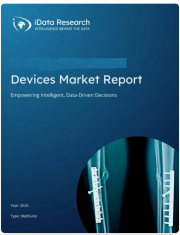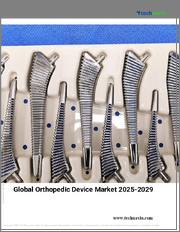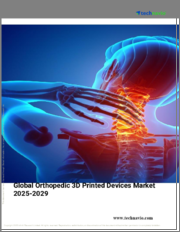
|
시장보고서
상품코드
1748781
정형외과용 디바이스 시장 : 세계 산업 규모, 점유율, 동향, 기회, 예측, 제품별, 용도별, 지역별, 경쟁별(2020-2030년)Orthopedic Devices Market - Global Industry Size, Share, Trends, Opportunity, and Forecast, Segmented By Product, By Application, By Region and Competition, 2020-2030F |
||||||
세계의 정형외과용 디바이스 시장은 2024년에 542억 7,000만 달러로 평가되며, 2030년에는 700억 7,000만 달러에 달할 것으로 예측되며, CAGR은 4.55%를 기록합니다.
시장 확대의 원동력은 근골격계 질환의 유병률 증가, 꾸준한 고령화, 장비 공학 및 수술 기술의 끊임없는 발전입니다. 관절 재건술, 외상 고정술, 척추 이식술, 정형외과 지원 솔루션 등에 대한 수요 증가는 급속한 기술 혁신, 제품 다양화, 국제 시장으로의 침투를 촉진하고 있습니다. 그러나 업계는 특히 중저소득 국가에서 기술적으로 진보된 임플란트 및 수술의 높은 비용과 같은 지속적인 장애물에 직면해 있습니다. 의료기기 승인에 대한 규제 장벽과 지역적으로 숙련된 정형외과 전문의의 부족은 시장의 확장성 및 복잡한 수술 기법의 채택을 더욱 제한하고 있습니다.
| 시장 개요 | |
|---|---|
| 예측 기간 | 2026-2030년 |
| 시장 규모 : 2024년 | 542억 7,000만 달러 |
| 시장 규모 : 2030년 | 700억 7,000만 달러 |
| CAGR : 2025-2030년 | 4.55% |
| 급성장 부문 | 액세서리 |
| 최대 시장 | 북미 |
주요 시장 성장 촉진요인
헬스케어 산업의 성장
주요 시장 이슈
장비 및 치료의 높은 비용
주요 시장 동향
오르토바이오로직스 수요 증가
목차
제1장 개요
제2장 조사 방법
제3장 개요
제4장 COVID-19가 세계의 정형외과용 디바이스 시장에 미치는 영향
제5장 세계의 정형외과용 디바이스 시장 전망
- 시장 규모·예측
- 금액별
- 시장 점유율·예측
- 제품별(액세서리, 외과용 기기)
- 용도별(고관절 정형외과용 기기, 슬관절 정형외과용 기기, 척추 정형외과용 기기, 두개악안면 정형외과용 기기, 치과 정형외과용 기기, 스포츠 상해, 기타)
- 지역별
- 기업별(2024년)
- 시장 맵
제6장 북미의 정형외과용 디바이스 시장 전망
- 시장 규모·예측
- 시장 점유율·예측
- 북미 : 국가별 분석
- 미국
- 멕시코
- 캐나다
제7장 유럽의 정형외과용 디바이스 시장 전망
- 시장 규모·예측
- 시장 점유율·예측
- 유럽 : 국가별 분석
- 프랑스
- 독일
- 영국
- 이탈리아
- 스페인
제8장 아시아태평양의 정형외과용 디바이스 시장 전망
- 시장 규모·예측
- 시장 점유율·예측
- 아시아태평양 : 국가별 분석
- 중국
- 인도
- 한국
- 일본
- 호주
제9장 남미의 정형외과용 디바이스 시장 전망
- 시장 규모·예측
- 시장 점유율·예측
- 남미 : 국가별 분석
- 브라질
- 아르헨티나
- 콜롬비아
제10장 중동 및 아프리카의 정형외과용 디바이스 시장 전망
- 시장 규모·예측
- 시장 점유율·예측
- 중동 및 아프리카 : 국가별 분석
- 남아프리카공화국
- 사우디아라비아
- 아랍에미리트
제11장 시장 역학
- 촉진요인
- 과제
제12장 시장 동향과 발전
- 합병과 인수
- 제품 출시
- 최근 동향
제13장 혼란 : 분쟁, 팬데믹, 무역장벽
제14장 세계의 정형외과용 디바이스 시장 : SWOT 분석
제15장 Porter's Five Forces 분석
- 업계내 경쟁
- 신규 참여의 가능성
- 공급업체의 힘
- 고객의 힘
- 대체품의 위협
제16장 경쟁 구도
- Medtronic PLC
- Stryker Corp.
- B Braun Melsungen AG
- CONMED Corp.
- Smith & Nephew PLC
- Johnson & Johnson Services, Inc.
- NuVasive Inc.
- Zimmer Biomet Holdings Inc
- Globus Medical Inc
- DJO Global Inc
제17장 전략적 제안
제18장 조사회사 소개·면책사항
KSA 25.06.24The Global Orthopedic Devices Market was valued at USD 54.27 Billion in 2024 and is projected to reach USD 70.07 Billion by 2030, registering a CAGR of 4.55%. Market expansion is being driven by the growing prevalence of musculoskeletal conditions, a steadily aging population, and continuous advancements in device engineering and surgical technologies. Increasing demand for procedures such as joint reconstruction, trauma fixation, spinal implantation, and orthopedic support solutions is prompting rapid innovation, product diversification, and international market penetration. However, the industry faces ongoing hurdles, including the high costs of technologically advanced implants and surgical operations, particularly in low- and middle-income economies. Regulatory hurdles in device approval and regional shortages of trained orthopedic professionals further restrict market scalability and the adoption of complex surgical techniques.
| Market Overview | |
|---|---|
| Forecast Period | 2026-2030 |
| Market Size 2024 | USD 54.27 Billion |
| Market Size 2030 | USD 70.07 Billion |
| CAGR 2025-2030 | 4.55% |
| Fastest Growing Segment | Accessories |
| Largest Market | North America |
Key Market Drivers
Growth in Healthcare Industry
The healthcare industry, generating over USD 4 trillion annually, continues to be a critical growth driver for the orthopedic devices market. Pharmaceuticals and biotechnology contribute around USD 850 billion, while medical technology and diagnostics add more than USD 400 billion to global healthcare revenues. This growth has translated into increasing diagnosis and treatment of orthopedic conditions like osteoarthritis, rheumatoid arthritis, osteoporosis, and trauma-related injuries. The rise in aging populations globally has further amplified the demand for orthopedic solutions. Concurrently, the healthcare sector's push toward improved surgical precision and patient care is fostering adoption of innovative technologies such as robotic-assisted systems, 3D-printed implants, and minimally invasive surgical tools. Instruments like the ferromagnetic wand, argon beam coagulators, Sonicision devices, and conventional bipolar systems are enhancing surgical outcomes, maneuverability, and cost-effectiveness, directly supporting efforts to elevate clinical care while optimizing long-term healthcare expenditure.
Key Market Challenges
High Cost of Devices and Procedures
A significant constraint to growth in the orthopedic devices market is the high cost of surgical procedures and associated equipment. Orthopedic interventions often utilize technologically advanced and high-grade materials, resulting in elevated production and acquisition expenses. These operations typically require experienced surgeons, sophisticated operating facilities, and extended recovery care, further compounding total treatment costs. Although insurance coverage in developed countries may offer partial relief, reimbursement plans frequently exclude newer or premium solutions. In regions with limited healthcare infrastructure, these financial pressures significantly curtail access to advanced orthopedic devices, hindering widespread market penetration.
Key Market Trends
Rising Demand for Orthobiologics
The orthopedic devices market is experiencing a growing shift toward orthobiologics as regenerative treatment alternatives become increasingly preferred. Orthobiologics-including bone grafts, platelet-rich plasma (PRP), stem cells, and demineralized bone matrices-offer natural healing benefits for bones, joints, and soft tissues. These biologic therapies are being incorporated more widely into minimally invasive procedures for conditions such as osteoarthritis, spinal degeneration, and sports injuries. Key factors fueling this trend include a rising geriatric population and the increasing prevalence of chronic orthopedic conditions. Patients and providers alike are favoring orthobiologics for their ability to reduce recovery times and post-surgical complications, making them a vital component in modern orthopedic applications such as spinal fusion, joint reconstruction, and fracture repair.
Key Market Players
- Medtronic PLC
- Stryker Corp.
- B Braun Melsungen AG
- CONMED Corp.
- Smith & Nephew PLC
- Johnson & Johnson Services, Inc.
- NuVasive Inc.
- Zimmer Biomet Holdings Inc
- Globus Medical Inc
- DJO Global Inc
Report Scope
In this report, the Global Orthopedic Devices Market has been segmented into the following categories, in addition to the industry trends which have also been detailed below:
Orthopedic Devices Market, By Product:
- Accessories
- Surgical Devices
Orthopedic Devices Market, By Application:
- Hip Orthopedic Devices
- Knee Orthopedic Devices
- Spine Orthopedic Devices
- Craniomaxillofacial Orthopedic Devices
- Dental Orthopedic Devices
- Sports Injuries
- Others
Orthopedic Devices Market, By Region:
- North America
- United States
- Canada
- Mexico
- Europe
- France
- United Kingdom
- Italy
- Germany
- Spain
- Asia Pacific
- China
- India
- Japan
- Australia
- South Korea
- South America
- Brazil
- Argentina
- Colombia
- Middle East & Africa
- South Africa
- Saudi Arabia
- UAE
Competitive Landscape
Company Profiles: Detailed analysis of the major companies present in the Global Orthopedic Devices Market.
Available Customizations
Global Orthopedic Devices Market report with the given market data, TechSci Research offers customizations according to a company's specific needs. The following customization options are available for the report:
Company Information
- Detailed analysis and profiling of additional market players (up to five).
Table of Contents
1. Product Overview
- 1.1. Market Definition
- 1.2. Scope of the Market
- 1.2.1. Markets Covered
- 1.2.2. Years Considered for Study
- 1.2.3. Key Market Segmentations
2. Research Methodology
- 2.1. Objective of the Study
- 2.2. Baseline Methodology
- 2.3. Key Industry Partners
- 2.4. Major Association and Secondary Sources
- 2.5. Forecasting Methodology
- 2.6. Data Triangulation & Validation
- 2.7. Assumptions and Limitations
3. Executive Summary
- 3.1. Overview of the Market
- 3.2. Overview of Key Market Segmentations
- 3.3. Overview of Key Market Players
- 3.4. Overview of Key Regions/Countries
- 3.5. Overview of Market Drivers, Challenges, and Trends
4. Impact of COVID-19 on Global Orthopedic Devices Market
5. Global Orthopedic Devices Market Outlook
- 5.1. Market Size & Forecast
- 5.1.1. By Value
- 5.2. Market Share & Forecast
- 5.2.1. By Product (Accessories, Surgical Devices)
- 5.2.2. By Application (Hip Orthopedic Devices, Knee Orthopedic Devices, Spine Orthopedic Devices, Craniomaxillofacial Orthopedic Devices, Dental Orthopedic Devices, Sports Injuries, Others)
- 5.2.3. By Region
- 5.2.4. By Company (2024)
- 5.3. Market Map
6. North America Orthopedic Devices Market Outlook
- 6.1. Market Size & Forecast
- 6.1.1. By Value
- 6.2. Market Share & Forecast
- 6.2.1. By Product
- 6.2.2. By Application
- 6.2.3. By Country
- 6.3. North America: Country Analysis
- 6.3.1. United States Orthopedic Devices Market Outlook
- 6.3.1.1. Market Size & Forecast
- 6.3.1.1.1. By Value
- 6.3.1.2. Market Share & Forecast
- 6.3.1.2.1. By Product
- 6.3.1.2.2. By Application
- 6.3.1.1. Market Size & Forecast
- 6.3.2. Mexico Orthopedic Devices Market Outlook
- 6.3.2.1. Market Size & Forecast
- 6.3.2.1.1. By Value
- 6.3.2.2. Market Share & Forecast
- 6.3.2.2.1. By Product
- 6.3.2.2.2. By Application
- 6.3.2.1. Market Size & Forecast
- 6.3.3. Canada Orthopedic Devices Market Outlook
- 6.3.3.1. Market Size & Forecast
- 6.3.3.1.1. By Value
- 6.3.3.2. Market Share & Forecast
- 6.3.3.2.1. By Product
- 6.3.3.2.2. By Application
- 6.3.3.1. Market Size & Forecast
- 6.3.1. United States Orthopedic Devices Market Outlook
7. Europe Orthopedic Devices Market Outlook
- 7.1. Market Size & Forecast
- 7.1.1. By Value
- 7.2. Market Share & Forecast
- 7.2.1. By Product
- 7.2.2. By Application
- 7.2.3. By Country
- 7.3. Europe: Country Analysis
- 7.3.1. France Orthopedic Devices Market Outlook
- 7.3.1.1. Market Size & Forecast
- 7.3.1.1.1. By Value
- 7.3.1.2. Market Share & Forecast
- 7.3.1.2.1. By Product
- 7.3.1.2.2. By Application
- 7.3.1.1. Market Size & Forecast
- 7.3.2. Germany Orthopedic Devices Market Outlook
- 7.3.2.1. Market Size & Forecast
- 7.3.2.1.1. By Value
- 7.3.2.2. Market Share & Forecast
- 7.3.2.2.1. By Product
- 7.3.2.2.2. By Application
- 7.3.2.1. Market Size & Forecast
- 7.3.3. United Kingdom Orthopedic Devices Market Outlook
- 7.3.3.1. Market Size & Forecast
- 7.3.3.1.1. By Value
- 7.3.3.2. Market Share & Forecast
- 7.3.3.2.1. By Product
- 7.3.3.2.2. By Application
- 7.3.3.1. Market Size & Forecast
- 7.3.4. Italy Orthopedic Devices Market Outlook
- 7.3.4.1. Market Size & Forecast
- 7.3.4.1.1. By Value
- 7.3.4.2. Market Share & Forecast
- 7.3.4.2.1. By Product
- 7.3.4.2.2. By Application
- 7.3.4.1. Market Size & Forecast
- 7.3.5. Spain Orthopedic Devices Market Outlook
- 7.3.5.1. Market Size & Forecast
- 7.3.5.1.1. By Value
- 7.3.5.2. Market Share & Forecast
- 7.3.5.2.1. By Product
- 7.3.5.2.2. By Application
- 7.3.5.1. Market Size & Forecast
- 7.3.1. France Orthopedic Devices Market Outlook
8. Asia Pacific Orthopedic Devices Market Outlook
- 8.1. Market Size & Forecast
- 8.1.1. By Value
- 8.2. Market Share & Forecast
- 8.2.1. By Product
- 8.2.2. By Application
- 8.2.3. By Country
- 8.3. Asia Pacific: Country Analysis
- 8.3.1. China Orthopedic Devices Market Outlook
- 8.3.1.1. Market Size & Forecast
- 8.3.1.1.1. By Value
- 8.3.1.2. Market Share & Forecast
- 8.3.1.2.1. By Product
- 8.3.1.2.2. By Application
- 8.3.1.1. Market Size & Forecast
- 8.3.2. India Orthopedic Devices Market Outlook
- 8.3.2.1. Market Size & Forecast
- 8.3.2.1.1. By Value
- 8.3.2.2. Market Share & Forecast
- 8.3.2.2.1. By Product
- 8.3.2.2.2. By Application
- 8.3.2.1. Market Size & Forecast
- 8.3.3. South Korea Orthopedic Devices Market Outlook
- 8.3.3.1. Market Size & Forecast
- 8.3.3.1.1. By Value
- 8.3.3.2. Market Share & Forecast
- 8.3.3.2.1. By Product
- 8.3.3.2.2. By Application
- 8.3.3.1. Market Size & Forecast
- 8.3.4. Japan Orthopedic Devices Market Outlook
- 8.3.4.1. Market Size & Forecast
- 8.3.4.1.1. By Value
- 8.3.4.2. Market Share & Forecast
- 8.3.4.2.1. By Product
- 8.3.4.2.2. By Application
- 8.3.4.1. Market Size & Forecast
- 8.3.5. Australia Orthopedic Devices Market Outlook
- 8.3.5.1. Market Size & Forecast
- 8.3.5.1.1. By Value
- 8.3.5.2. Market Share & Forecast
- 8.3.5.2.1. By Product
- 8.3.5.2.2. By Application
- 8.3.5.1. Market Size & Forecast
- 8.3.1. China Orthopedic Devices Market Outlook
9. South America Orthopedic Devices Market Outlook
- 9.1. Market Size & Forecast
- 9.1.1. By Value
- 9.2. Market Share & Forecast
- 9.2.1. By Product
- 9.2.2. By Application
- 9.2.3. By Country
- 9.3. South America: Country Analysis
- 9.3.1. Brazil Orthopedic Devices Market Outlook
- 9.3.1.1. Market Size & Forecast
- 9.3.1.1.1. By Value
- 9.3.1.2. Market Share & Forecast
- 9.3.1.2.1. By Product
- 9.3.1.2.2. By Application
- 9.3.1.1. Market Size & Forecast
- 9.3.2. Argentina Orthopedic Devices Market Outlook
- 9.3.2.1. Market Size & Forecast
- 9.3.2.1.1. By Value
- 9.3.2.2. Market Share & Forecast
- 9.3.2.2.1. By Product
- 9.3.2.2.2. By Application
- 9.3.2.1. Market Size & Forecast
- 9.3.3. Colombia Orthopedic Devices Market Outlook
- 9.3.3.1. Market Size & Forecast
- 9.3.3.1.1. By Value
- 9.3.3.2. Market Share & Forecast
- 9.3.3.2.1. By Product
- 9.3.3.2.2. By Application
- 9.3.3.1. Market Size & Forecast
- 9.3.1. Brazil Orthopedic Devices Market Outlook
10. Middle East and Africa Orthopedic Devices Market Outlook
- 10.1. Market Size & Forecast
- 10.1.1. By Value
- 10.2. Market Share & Forecast
- 10.2.1. By Product
- 10.2.2. By Application
- 10.2.3. By Country
- 10.3. MEA: Country Analysis
- 10.3.1. South Africa Orthopedic Devices Market Outlook
- 10.3.1.1. Market Size & Forecast
- 10.3.1.1.1. By Value
- 10.3.1.2. Market Share & Forecast
- 10.3.1.2.1. By Product
- 10.3.1.2.2. By Application
- 10.3.1.1. Market Size & Forecast
- 10.3.2. Saudi Arabia Orthopedic Devices Market Outlook
- 10.3.2.1. Market Size & Forecast
- 10.3.2.1.1. By Value
- 10.3.2.2. Market Share & Forecast
- 10.3.2.2.1. By Product
- 10.3.2.2.2. By Application
- 10.3.2.1. Market Size & Forecast
- 10.3.3. UAE Orthopedic Devices Market Outlook
- 10.3.3.1. Market Size & Forecast
- 10.3.3.1.1. By Value
- 10.3.3.2. Market Share & Forecast
- 10.3.3.2.1. By Product
- 10.3.3.2.2. By Application
- 10.3.3.1. Market Size & Forecast
- 10.3.1. South Africa Orthopedic Devices Market Outlook
11. Market Dynamics
- 11.1. Drivers
- 11.2. Challenges
12. Market Trends & Developments
- 12.1. Merger & Acquisition (If Any)
- 12.2. Product Launches (If Any)
- 12.3. Recent Developments
13. Disruptions : Conflicts, Pandemics and Trade Barriers
14. Global Orthopedic Devices Market: SWOT Analysis
15. Porters Five Forces Analysis
- 15.1. Competition in the Industry
- 15.2. Potential of New Entrants
- 15.3. Power of Suppliers
- 15.4. Power of Customers
- 15.5. Threat of Substitute Products
16. Competitive Landscape
- 16.1. Medtronic PLC
- 16.1.1. Business Overview
- 16.1.2. Company Snapshot
- 16.1.3. Products & Services
- 16.1.4. Financials (As Reported)
- 16.1.5. Recent Developments
- 16.1.6. Key Personnel Details
- 16.1.7. SWOT Analysis
- 16.2. Stryker Corp.
- 16.3. B Braun Melsungen AG
- 16.4. CONMED Corp.
- 16.5. Smith & Nephew PLC
- 16.6. Johnson & Johnson Services, Inc.
- 16.7. NuVasive Inc.
- 16.8. Zimmer Biomet Holdings Inc
- 16.9. Globus Medical Inc
- 16.10. DJO Global Inc
17. Strategic Recommendations
18. About Us & Disclaimer
(주말 및 공휴일 제외)


















